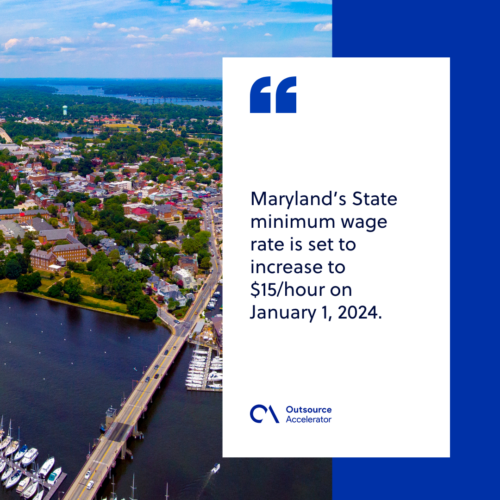A guide to the minimum wage in US states

- Alabama
- Alaska
- Arizona
- Arkansas
- California
- Colorado
- Connecticut
- Delaware
- Florida
- Georgia
- Hawaii
- Idaho
- Illinois
- Indiana
- Iowa
- Kansas
- Kentucky
- Louisiana
- Maine
- Maryland
- Massachusetts
- Michigan
- Minnesota
- Mississippi
- Missouri
- Montana
- Nebraska
- Nevada
- New Hampshire
- New Jersey
- New Mexico
- New York
- North Carolina
- North Dakota
- Ohio
- Oklahoma
- Oregon
- Pennsylvania
- Rhode Island
- South Carolina
- South Dakota
- Tennessee
- Texas
- Utah
- Vermont
- Virginia
- Washington
- West Virginia
- Wisconsin
- Wyoming
As an integral aspect of labor laws, the minimum wage sets the baseline for the lowest legal compensation that employers must provide to their employees.
If you’re new to this landscape, it can be surprising to discover that minimum wage varies per US state. Each has its approach to setting minimum wage rates, reflecting the unique economic factors and social considerations at play.
This guide delves into the reported minimum wage per US state and any special background behind it. It also covers some overtime pay rules. For a look at how overtime pay works in other countries, you can visit this article.
A brief overview of minimum wage in the USA
The minimum wage serves as the legally mandated lowest hourly wage. It serves as a foundational labor standard to ensure fair compensation for workers across various industries and regions.
In the United States, the minimum wage is established at both the federal and state levels. Each state has the freedom to set its own minimum wage rate according to local economic conditions. The requirement is that it meets or exceeds the federal minimum wage.
The Fair Labor Standards Act (FLSA) grants working citizens the right to a minimum wage. This is enforced by the Department of Labor’s Wage and Hour Division.
As of 2023, USAGov, the official online guide to government information and services in the US, reports the federal minimum wage is $7.25 per hour.
Additionally, there is a minimum wage for employees who receive tips, which is $2.13 per hour. The employer must pay the difference if the total with tips does not reach $7.25 per hour.
For a look at the minimum wage around the world, you may visit this article.

Minimum wage in the US per state
Take a look at the minimum wage in US states:
Note: States with no state minimum wage law require that employers subject to the Fair Labor Standards Act must pay the current minimum wage of $7.25 per hour.
1. Alabama
Minimum wage: No state minimum wage law.
Alabama minimum wage applies to most employees. Some exceptions include tipped employees, student workers, and certain occupations.
2. Alaska
Minimum wage: $10.85 per hour
The Alaska Department of Labor has approved a voluntary flexible work plan.
Under this plan, employers may institute an eight-hour day, 40-hour work week with premium pay (after a workday of eight hours). Overtime pay does not apply to those with four employees or less.
3. Arizona
Minimum wage: $13.85 per hour
Arizona increased its minimum wage from $12.80 to $13.85 as of January 1, 2023. This was done to account for the inflation witnessed in the period between August 2021 and August 2022.
4. Arkansas
Minimum wage: $11 per hour (for those with at least four employees)
Arkansas’s current minimum wage is the result of an annual rate increase that began on January 1, 2019. Employers who are covered by both Federal and State Laws must pay the higher minimum wage.
5. California
Minimum wage: $15.50 per hour
California Labor Code section 510 specifies that any work exceeding eight hours a day is qualified for overtime pay (one and one-half times the regular rate). Any work that exceeds 12 hours a day qualifies for double-time pay.
6. Colorado
Minimum wage: $13.65 per hour
In Colorado, minimum wage rate and overtime provisions apply to the following industries:
- Retail and service
- Commercial support service
- Food and beverage
- Health and medical
7. Connecticut
Minimum wage: $15 per hour
Connecticut’s minimum wage was increased from $14/hour to $15/hour on June 1, 2023. Should the federal minimum wage rate equal or exceed the State minimum, Connecticut’s minimum wage rate automatically increases by 0.5%.
8. Delaware
Minimum wage: $11.75 per hour
Should the federal minimum wage ever exceed the State minimum wage rate, Delaware will adopt the former.
9. Florida
Minimum wage: $11 per hour
Florida adjusts its minimum wage annually according to a set formula. The last increase is slated for September 30, 2023, which will increase to $12 per hour.
10. Georgia
Minimum wage: $5.15 per hour (for employers with six or more employees)
Employees under federal employment are exempt from Georgia State law. This applies if the federal minimum wage is greater than the State minimum.
11. Hawaii
Minimum wage: $12 per hour
Hawaii has an additional law where employees with a set monthly salary of at least $2000 are exempted from the State minimum wage and overtime law.
The State law also doesn’t cover any employment subject to the Fair Labor Standards Act if the federal wage is higher than the State’s.
12. Idaho
Minimum wage: $7.25 per hour
Employees below 20 years old are paid a training wage of $4.25/hour for the first 90 days on the job. Employers can also pay full-time student workers 85% of the State minimum wage for up to 20 hours/week at certain jobs.
13. Illinois
Minimum wage: $13 per hour (for those with four or more employees, excluding family members)
Workers in Illinois who are below 18 years old are paid a minimum wage of $10.50/hour. Tipped workers receive 60% of the State minimum wage.
14. Indiana
Minimum wage: $7.25 per hour (for those with two or more employees)
Indiana has not increased its minimum wage since 2008, when it instituted a $0.60 increase.
15. Iowa
Minimum wage: $7.25 per hour
The Iowa minimum wage is arranged to equal the federal minimum wage if it is ever set below the latter.
16. Kansas
Minimum wage: $7.25 per hour
Kansas State law does not cover any employment that is subject to the Fair Labor Standards Act.
17. Kentucky
Minimum wage: $7.25 per hour
Kentucky State overtime laws require employers to compensate those who work seven days in one work week. The required pay is one and one-half times the regular rate.
The State matches the federal minimum wage rate if the federal rate exceeds the State rate.
18. Louisiana
Minimum wage: No state minimum wage law.
Louisiana has not seen an increase in its minimum wage since 2008, when it was raised by $0.70.
19. Maine
Minimum wage: $13.80 per hour
The Maine State minimum wage is adjusted annually based on a set formula.
If the highest federal minimum wage increases to higher than the State minimum rate, then the latter must increase to the same amount, effective on the same day.
20. Maryland
Minimum wage: $13.25 per hour (for those with at least 15 employees); $12.80 per hour (for those with fewer than 15 employees)
Maryland’s State minimum wage rate is set to increase to $15/hour on January 1, 2024. This will apply to all employers regardless of company size.

21. Massachusetts
Minimum wage: $15 per hour
Massachusetts law states that the State minimum wage shall in no case be less than $0.50 higher than the effective federal rate.
22. Michigan
Minimum wage: $10.10 (for those with at least two employees)
The Michigan State minimum wage was previously set to increase annually during the period from 2019 to 2030. The new minimum wage would have plateaued at $12/hour, but this initiative has since been paused.
23. Minnesota
Minimum wage: $10.59 per hour (for enterprises with annual revenues of at least $500,000); $8.63 (for enterprises with annual revenues of less than $500,000)
Minnesota’s State minimum wage follows a set formula and is adjusted annually. The minimum wage for minors (below 18 years old) is set at $8.63/hour.
24. Mississippi
Minimum wage: No state minimum wage law.
Mississippi has not changed its minimum wage since 2008, when it raised the amount by $0.70.
25. Missouri
Minimum wage: $12 per hour
The Missouri State law does not cover those under federal employment. Additionally, the law exempts retail or service business employees with gross annual sales of less than $500,000.
26. Montana
Minimum wage: $9.95 per hour (for businesses with gross annual sales of more than $110,000); $4 per hour (for businesses with gross annual sales of $110,000 or lower)
If a business has an individual employee producing or moving goods between states, that employee must be paid the greater wage between the Federal and State minimum rate.
27. Nebraska
Minimum wage: $10.50 per hour (for those with four or more employees)
After passing Initiative 433, Nebraska will experience a minimum wage increase beginning Jan.1, 2023. The plan is to gradually raise the value by $1.50 every year, eventually reaching a minimum wage of $15/hour by 2026.
28. Nevada
Minimum wage: $11.25 (if employer does not offer qualifying health insurance); $10.25 (if employer offers qualifying health insurance)
Nevada set new rules regarding its minimum wage, effective July 1 2023. By July 1, 2024, there will be a new uniform minimum wage of $12/hour for all employees.
29. New Hampshire
Minimum wage: $7.25 per hour
The New Hampshire minimum wage increases to match the federal minimum wage when the former is set below the latter rate.
30. New Jersey
Minimum wage: $14.13 per hour
New Jersey’s minimum wage is adjusted annually according to a set formula. There is also a minimum wage of $12.93/hour for seasonal and small employers hiring less than six people.
31. New Mexico
Minimum wage: $12 per hour
The New Mexico minimum wage has steadily increased in recent years due to a 2019 State law. Amendments are being proposed to increase to $16/hour in 2024.
32. New York
Minimum wage: $14.20 per hour; $15 per hour (for those on Long Island, Westchester, and New York City)
New York has hospitality regulations entitling overtime pay for residential workers. Overtime pay qualifies for those who worked at least 40 hours/week, compared to the previous 44.
Additionally, premium pay is given to those in occupations that require 24 hours of consecutive rest if they worked during the said period.
33. North Carolina
Minimum wage: $7.25 per hour
North Carolina employers must provide premium pay after 45-hour work weeks for seasonal amusements or recreational establishments.
34. North Dakota
Minimum wage: $7.25 per hour
North Dakota minimum wage currently follows the federal standard. A bill was introduced in 2021 to raise the amount to $9/hour in 2022, then annually increase it to $15/hour by 2027, but this initiative died in the House.
35. Ohio
Minimum wage: $10.10 per hour (for employers with annual gross receipts of at least $372,000); $7.25 per hour (for employers with annual gross receipts under $372,000)
Ohio’s minimum wage rate is adjusted annually based on a set formula.
36. Oklahoma
Minimum wage: $7.25 per hour (for employers with ten or more employees at any one location or with annual gross sales over $100,000); $2 per hour (for all other employers)
Oklahoma’s State law does not contain current dollar minimums. The State, therefore, applies the federal minimum wage.
37. Oregon
Minimum wage: $14.20 per hour (standard state rate); $15.45 per hour (for the Portland Metro Area); $13.20 per hour (for non-urban counties)
Oregon employers must provide premium pay after ten hours/day for those employed in the following:
- Non-farm canneries
- Driers
- Packing plants
- Mills
- Factories
- Other manufacturing establishments excluding sawmills, planing mills, shingle mills, and logging camps
38. Pennsylvania
Minimum wage: $7.25 per hour
In June 2023, Pennsylvania passed a measure to raise the State minimum wage to $15/hour by 2026.
39. Rhode Island
Minimum wage: $13 per hour
Rhode Island has separate laws from the State minimum wage law that requires employers to provide time and a half premium pay for work on Sundays and holidays. This applies in retail and certain businesses.
40. South Carolina
Minimum wage: No state minimum wage law.
South Carolina’s minimum wage has remained unchanged since 2008, when it increased by $0.70.
41. South Dakota
Minimum wage: $10.80 per hour
South Dakota also has a separate minimum wage for workers who receive tips, from $4.98 to $5.40 per hour.
42. Tennessee
Minimum wage: No state minimum wage law.
Tennessee follows the federal minimum wage, and this has been the case for several years.

43. Texas
Minimum wage: $7.25 per hour
Texas applies the federal minimum rate due to not containing current dollar minimums. Any worker under federal employment is exempt from State law coverage.
44. Utah
Minimum wage: $7.25 per hour
Utah applies the federal minimum rate due to not containing current dollar minimums. Any worker under federal employment is exempt from State law coverage.
45. Vermont
Minimum wage: $13.18 per hour (for those with at least two employees)
Should the federal minimum wage increase to higher than Vermont’s minimum wage, the State rate automatically rises to match it.
46. Virginia
Minimum wage: $12 per hour
Virginia legislation gradually raised the minimum wage beginning in May 2021. It is set to reach $15/hour by January 2026.
47. Washington
Minimum wage: $15.74 per hour
Premium pay in Washington may be exchanged for compensating time off. Washington follows a set formula to adjust its minimum wage annually
48. West Virginia
Minimum wage: $8.75 per hour (for those with at least six employees at one location)
West Virginia has not increased its minimum wage since 2016, when it saw an increase of $0.75.
49. Wisconsin
Minimum wage: $7.25 per hour
Wisconsin minimum wage has matched the federal standard since 2009. Ongoing pushes exist to increase it to $15/hour to account for inflation and a rising cost of living.
50. Wyoming
Minimum wage: $5.15 per hour
Employers in Wyoming that the Fair Labor Standards Act covers must pay their employees the federal minimum wage.







 Independent
Independent




